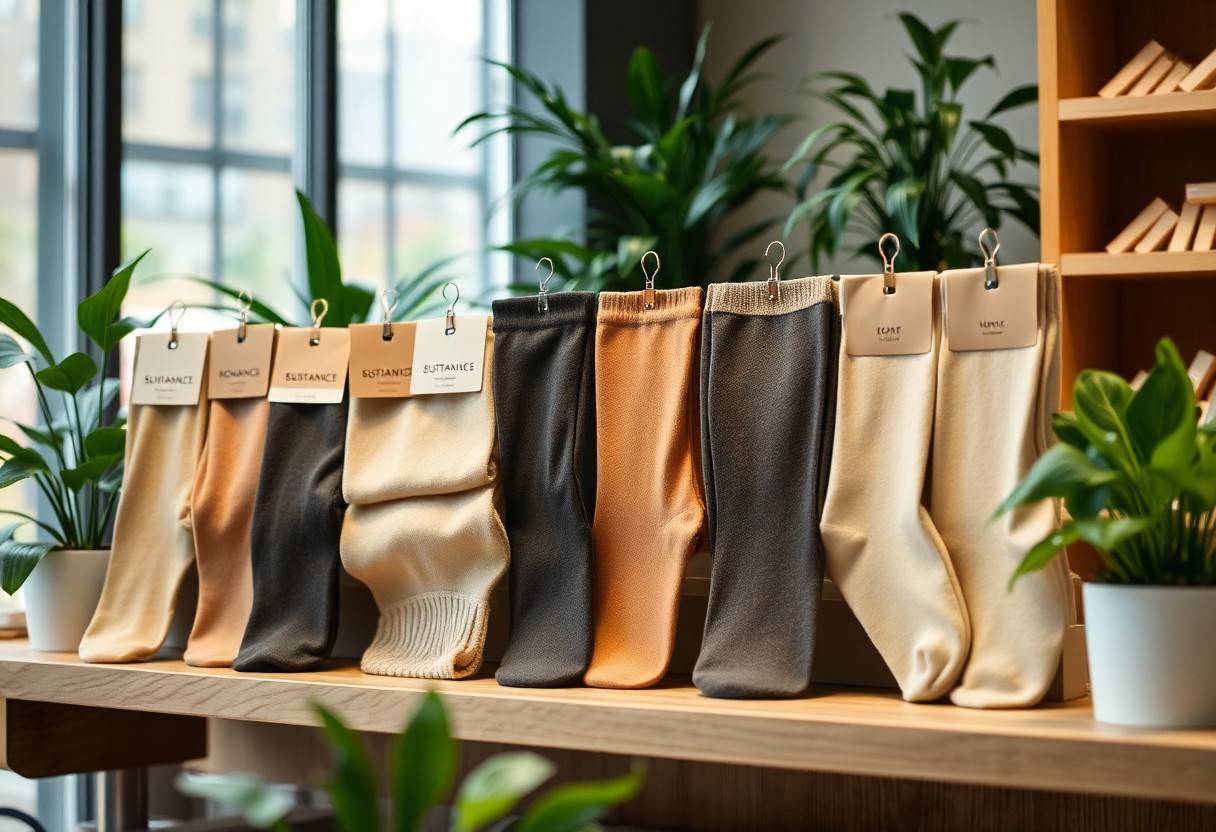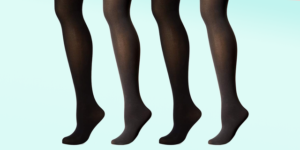Many of your favorite hosiery pieces might be contributing to environmental waste without you realizing it. As you become more conscious about your fashion choices, understanding sustainable hosiery options can help you make better purchasing decisions. From biodegradable materials to recycled yarns, the hosiery industry is evolving to meet your eco-friendly needs. Whether you’re looking for everyday tights or special occasion stockings, discovering sustainable alternatives can reduce your fashion footprint while maintaining the style and comfort you expect from quality hosiery.
Environmental Impact of Traditional Hosiery
As you explore your hosiery choices, it’s crucial to understand that conventional hosiery production takes a significant toll on the environment. Your everyday tights and stockings are typically made from synthetic materials like nylon and spandex, which are petroleum-based products requiring extensive energy consumption during manufacturing. These materials can take up to 40 years to decompose in landfills, contributing to the growing problem of textile waste.
Synthetic Materials and Pollution
To grasp the full environmental impact of your hosiery, consider that every time you wash synthetic tights, they release microplastics into water systems. These tiny particles, measuring less than 5mm, make their way into oceans and waterways, where they harm marine life and enter the food chain. Research shows that a single wash of synthetic garments can release up to 700,000 microfibers into the environment.
Production Waste and Carbon Footprint
For every pair of tights you purchase, approximately 66% more carbon dioxide is produced compared to making the same weight of cotton garments. The traditional hosiery industry’s manufacturing processes involve energy-intensive machinery, chemical treatments, and synthetic dye applications, all contributing to greenhouse gas emissions.
It’s worth noting that the fashion industry, including hosiery production, generates about 10% of global carbon emissions, surpassing international flights and maritime shipping combined. Your conventional tights also contribute to water pollution through the dyeing and finishing processes, with the industry using approximately 2,000 different chemicals in textile processing, many of which end up in local water systems.
Sustainable Materials in Modern Hosiery
Clearly, the hosiery industry is evolving to meet your eco-conscious needs with innovative sustainable materials. As you look for environmentally responsible options, you’ll find that modern sustainable hosiery combines comfort with environmental stewardship. Leading brands are now incorporating recycled materials and natural fibers, as highlighted in this comprehensive guide to eco-friendly hosiery options for colder seasons.
Recycled Nylon and Polyester
Around 60% of modern sustainable hosiery is made from recycled materials, primarily from post-consumer waste like fishing nets and plastic bottles. When you choose recycled nylon or polyester hosiery, you’re helping reduce waste while enjoying the same durability and stretch you expect from traditional materials. These innovative materials require up to 80% less energy to produce compared to virgin synthetic fibers.
Organic Cotton and Natural Fibers
Organic cotton and other natural fibers represent a significant shift in hosiery manufacturing, offering you breathable, skin-friendly alternatives to synthetic materials. When you select organic cotton hosiery, you’re choosing products grown without harmful pesticides and processed using water-conserving methods. These natural fibers require 90% less water to produce than conventional cotton.
It’s worth noting that natural fiber hosiery provides additional benefits beyond environmental sustainability. Your skin will appreciate the hypoallergenic properties of organic materials, while the biodegradable nature of these fibers means they’ll decompose naturally at the end of their lifecycle, typically within 5 years compared to 30-40 years for synthetic materials.
Leading Eco-Friendly Hosiery Brands
Any search for sustainable hosiery will reveal a growing number of brands committed to eco-friendly practices. You’ll find companies using recycled materials, implementing zero-waste policies, and ensuring ethical production methods. These brands typically offer products made from sustainable fibers like organic cotton, recycled nylon, and innovative biodegradable materials, helping you reduce your fashion footprint while maintaining style.
European Sustainable Manufacturers
On the European continent, you’ll discover some of the most innovative sustainable hosiery manufacturers. Swedish Stockings, for example, produces their pieces from recycled nylon and offers a recycling program where you can send your old tights for reprocessing. Companies like this typically reduce water usage by up to 90% compared to traditional manufacturing methods, and you can feel confident knowing your purchase supports circular fashion principles.
North American Green Innovators
One of the most striking features of North American sustainable hosiery brands is their commitment to local production and innovative materials. You’ll find companies using breakthrough technologies to create biodegradable tights that decompose within 3-5 years, compared to the 40-100 years needed for conventional synthetics. These brands often maintain transparency in their supply chains, allowing you to trace your products from source to shelf.
Leading North American manufacturers are revolutionizing the industry with their approach to packaging and distribution. You can now find hosiery brands that use 100% plastic-free packaging and carbon-neutral shipping options. Many of these companies also partner with environmental organizations, allowing you to contribute to conservation efforts through your purchases, with some donating up to 10% of their profits to environmental causes.
Ethical Production Practices
Many sustainable hosiery brands are revolutionizing the industry by implementing ethical production practices that prioritize both environmental responsibility and worker welfare. You’ll find these companies are moving away from traditional manufacturing methods that often rely on exploitative labor and harmful chemicals, instead adopting processes that minimize environmental impact while ensuring fair working conditions.
Fair Labor Standards
Along with environmental considerations, ethical hosiery brands are setting new standards for worker treatment and compensation. When you choose products from these companies, you’re supporting businesses that provide living wages, safe working conditions, and reasonable working hours. Many of these brands have obtained certifications like Fair Trade or SA8000, which verify their commitment to worker welfare and ethical labor practices.
Transparent Supply Chains
Around 80% of consumers now demand transparency in their clothing purchases, and sustainable hosiery brands are responding by making their supply chains fully visible. You can often trace your hosiery from raw material sourcing to final production, with many brands providing detailed information about their manufacturing facilities and partners on their websites or product labels.
At every stage of production, transparent supply chains allow you to verify the ethical standards of your hosiery purchases. These brands typically provide documentation of their sustainability certifications, factory conditions, and material sourcing practices, helping you make informed decisions about your purchases while ensuring your values align with the products you choose.
Waste Reduction Initiatives
To minimize your environmental impact when purchasing hosiery, you’ll find numerous brands implementing innovative waste reduction strategies throughout their production processes. From utilizing pre-consumer textile waste to optimizing cutting patterns, these initiatives help reduce the estimated 12 million tons of textile waste generated annually in the fashion industry.
Circular Economy in Hosiery
With circular economy principles, you can now find hosiery brands that design their products with end-of-life considerations in mind. These companies create tights and stockings that can be easily disassembled into their component materials, making recycling more efficient and reducing the amount of waste that ends up in landfills.
Recycling Programs
For your worn-out tights and stockings, many sustainable hosiery brands now offer take-back programs, allowing you to return used items for proper recycling. These programs help transform old hosiery into new products, from clothing items to industrial materials, significantly reducing waste in the textile industry.
For instance, you can participate in recycling initiatives where your old nylon stockings are transformed into carpets, swimming suits, or even furniture. Companies like Swedish Stockings have implemented successful recycling programs that have already collected over 10,000 pairs of tights, demonstrating how your conscious choices can contribute to reducing textile waste in landfills.
Consumer Guide to Sustainable Choices
All your hosiery choices can make a significant impact on the environment. When shopping for sustainable hosiery, you should look for brands using recycled materials like ECONYL® (regenerated nylon from ocean waste), organic cotton, or biodegradable fibers. Your selection criteria should include transparent supply chains, fair labor practices, and eco-friendly packaging. Many sustainable hosiery brands now offer products made from up to 90% recycled materials, reducing the carbon footprint by approximately 50% compared to conventional production methods.
Care and Maintenance
Consumer habits play a vital role in extending the life of your hosiery items. You can significantly increase the longevity of your sustainable hosiery by hand washing in cold water with mild detergent, avoiding fabric softeners, and air drying away from direct sunlight. Your gentle care routine will not only preserve the garment’s quality but also reduce the microfiber release into waterways by up to 70%.
Disposal and Recycling Options
Before discarding your worn-out hosiery, you should explore various recycling options available. Your local textile recycling programs might accept nylon-based hosiery products, while some sustainable brands offer take-back programs where you can return used items for proper recycling. These programs typically convert old hosiery into new textile products or industrial materials.
Plus, you can find creative ways to repurpose your old hosiery at home. Your worn-out tights can serve as plant ties in the garden, cleaning cloths, or craft materials. Several hosiery brands now participate in circular economy initiatives, with some reporting up to 40% of their products being made from recycled materials collected through customer return programs.
Final Words
Ultimately, your choice of sustainable hosiery can make a significant impact on both the environment and the fashion industry. By selecting eco-friendly brands that prioritize renewable materials, ethical manufacturing processes, and innovative recycling programs, you’re not just investing in quality legwear – you’re contributing to a more sustainable future for fashion.
When you make conscious decisions about your hosiery purchases, you become part of a growing movement toward responsible consumption. Your support of sustainable hosiery brands helps drive industry-wide changes, encouraging more manufacturers to adopt environmentally friendly practices. As you build your sustainable wardrobe, keep in mind that even small choices in everyday items like tights and stockings can lead to meaningful environmental benefits over time.









